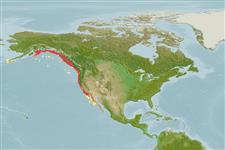Common names from other countries
Teleostei (teleosts) >
Perciformes/Scorpaenoidei (Scorpionfishes) >
Sebastidae (Rockfishes, rockcods and thornyheads) > Sebastinae
Etymology: Sebastes: Greek, sebastes = august, venerable (Ref. 45335); diploproa: From the Greek diploos and prora, meaning 'double' and 'prow' (Ref. 27436).
More on author: Gilbert.
Environment: milieu / climate zone / depth range / distribution range
Ecology
Marine; bathydemersal; depth range 0 - 800 m (Ref. 6793), usually 91 - 579 m (Ref. 2850). Deep-water; 60°N - 27°N, 168°W - 109°W
Northeast Pacific: Alaska Peninsula to Cedros Island, Baja California and the Gulf of California in Mexico.
Length at first maturity / Size / Weight / Age
Maturity: Lm 19.0, range 18 - ? cm
Max length : 46.0 cm TL male/unsexed; (Ref. 4925); max. published weight: 810.00 g (Ref. 40637); max. reported age: 86 years (Ref. 56049)
Dorsal
spines
(total): 13;
Dorsal
soft rays
(total): 11-14;
Anal
spines: 3;
Anal
soft rays: 5 - 8;
Vertebrae: 26. Head spines strong - nasal, preocular, postocular, tympanic and parietal spines present, supraocular, coronal and nuchal spines absent (Ref. 27437). Toothed knob in front of each upper jaw, deep notch between jaws (Ref. 27437). Caudal fin moderately indented (Ref. 6885). A red rockfish, silver ventrally (Ref. 27437). Branchiostegal rays: 7 (Ref. 36715).
Common offshore, on soft bottoms (Ref. 2850). Young occur in shallow water, often at surface under drifting kelp (Ref. 2850). Viviparous, with planktonic larvae and pelagic juveniles (Ref. 36715, 34817). The biggest individuals are sometimes found in markets where the flesh is sold as rockfish fillet (Ref. 27436). Rarely caught by anglers (Ref. 27436).)
Gives birth in spring (Ref. 27436).
Eschmeyer, W.N., E.S. Herald and H. Hammann, 1983. A field guide to Pacific coast fishes of North America. Boston (MA, USA): Houghton Mifflin Company. xii+336 p. (Ref. 2850)
IUCN Red List Status (Ref. 130435)
CITES (Ref. 128078)
Not Evaluated
Threat to humans
Harmless
Human uses
Fisheries: minor commercial
More information
ReferencesAquacultureAquaculture profileStrainsGeneticsElectrophoresesHeritabilityDiseasesProcessingMass conversion
Tools
Special reports
Download XML
Internet sources
Estimates based on models
Preferred temperature (Ref.
115969): 4.4 - 8.6, mean 5.9 (based on 131 cells).
Phylogenetic diversity index (Ref.
82804): PD
50 = 0.5000 [Uniqueness, from 0.5 = low to 2.0 = high].
Bayesian length-weight: a=0.01000 (0.00499 - 0.02004), b=3.09 (2.92 - 3.26), in cm Total Length, based on LWR estimates for this Genus-body shape (Ref.
93245).
Trophic level (Ref.
69278): 3.5 ±0.39 se; based on food items.
Resilience (Ref.
120179): Low, minimum population doubling time 4.5 - 14 years (tm=5; tmax=86; Fec=14,000).
Fishing Vulnerability (Ref.
59153): Moderate vulnerability (36 of 100).
